
foreword | Historical Narratives | Resources | Links | Contact
INDIAN AFFAIRS
History reveals pieces of the puzzle.
From time to time it has been suggested by various federal government ministers, that the Indian Act should be eliminated in order to dismantle the "custodial bureaucracy" which for over a century has bound the First Nations peoples in a maze of regulations. Although the Assembly of First Nations Chiefs once agreed that the time had come for the demise of the Department of Indian Affairs, some Aboriginals oppose this for fear there could be a high cost to cutting these historic ties with Ottawa.
This dilemma remains largely unchanged from that articulated over two hundred years ago by Joseph Brant, the illustrious chief of the Six Nations, when he wrote that the Aboriginals
In His Own Words"must be convinced that change will not place them in a worse situation than they are in now. Change must occur accordance with strict adherence to the dictates of Justice and rigid observance of all compacts and engagements on the part of the white people, including fixed boundaries and territories described."
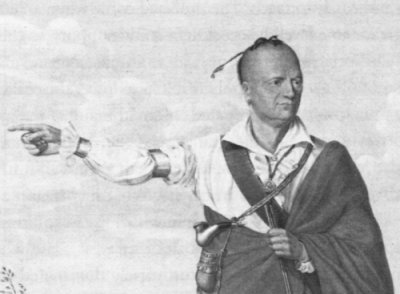 |
|
Joseph Brant, Chief of the Six Nations |
Brant wisely warned his people that they must foster "unity and concord among themselves" and encourage rather than discourage their own customs.
The origins of the Department of Indian Affairs can be traced to the days when our country was a colony and competition was intense to entice Aboriginals to become involved in the white man's wars. Britain was successful in securing an alliance with Native warriors, first against the French and later against the Americans. British officials challenged the Six Nations' sachems "to join us in our fight against the Bostonians." And they did.
Aboriginal affairs took on a new importance following the conquest of Canada. Previously, matters pertaining to the Natives had been handled in a makeshift manner, with disorganized, piecemeal record-keeping and no consistent, coherent policy. Now Indian Affairs began to be managed on a broader, more systematic basis. As frontiersmen and fur traders made their way westward, Pontiac's rebellion burst into flames in 1763, and as a result a more carefully considered plan became imperative. It was decided to keep settlers from going beyond the mountains until Aboriginal land titles could be extinguished.
A plan was designed in 1764 by which two Superintendents-General of Indian Affairs were appointed, both answerable directly to the Imperial government. [the name of the British government when it dealt with colonial affairs] Under their overall direction, various assistant superintendents and commissaries acted as go-betweens the whites and the Natives, administered law in the back country and in particular secured treaties for Native land titles.
As Superintendent of Indian Affairs, Sir John and Sir William Johnson were responsible for establishing a number of policies in this regard. Various of these policies became rooted in colonial law and eventually found their way into the Indian Act. The earliest legislation in this regard was directed largely at regulating trade with Natives and overseeing the sale of their lands. The Johnson frequently conferred with the Aboriginal sachems, settling grievances and renewing covenants of friendship with them on behalf of the Crown.
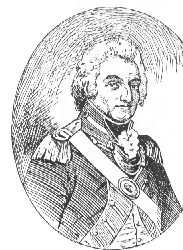 |
|
Sir John Johnson |
Some believe that the Indian Affairs bureaucracy began to be built at Fort Niagara on the banks of the Niagara River, the chief British point of contact with the Iroquois. The fort had been surrendered by the French to Johnson and a party of Native warriors in 1759. At the commencement of British-American hostilities in 1776, the nearest Aboriginal encampment was 80 miles from the fort. As the revolutionary war intensified, Britain's Native allies drew closer to the British base of operations until some two thousand had gathered in the vicinity of the fort.
The lands of the Six Nations originally extended roughly from Lake Ontario south to the Susquehanna River with the New York's Catskill Mountains closing in on the east and Lake Erie bordering on the west. Washington marked their settlements down for destruction, and in 1779 following a two-pronged American attack on Iroquois settlements in upper New York, five thousand Natives sought refuge near Niagara. They remained there until the end of the war, launching lightning raids from the fort to points all along the New York and Pennsylvania frontiers.
The Aboriginals were a free and independent people, subject neither to subordination nor domination. The cost of the conflict to them was high in lives and land lost, and as important allies of Britain they expected compensation. The compensation outlay rose rapidly over a short period of time with the quantity of provisions and presents increasing from 500 pounds at the commencement of the war in 1776 to 100,000 pounds by 1781. The expenditures required to provision the Natives at the three upper forts of Niagara, Detroit and Michilimackinac reportedly exceeded the cost of the whole British military establishment in Canada, exclusive of provisions.
It was feared the Americans might attempt to seize the western posts, and Lord Dorchester was instructed to recapture them if this did occur. If the posts were to remain in British hands, friendship with the Native peoples was critically important, for possession of the posts made possible control of the fur trade and defence of the colony. As a result the quantity of goods provided for the Native peoples was increased and Lord Dorchester was instructed to supply them with such "ammunition as might enable them to defend themselves" against the Americans. These supplies were funneled through the Indian Department and merchants who furnished them throughout the revolution became very wealthy. Among the goods distributed at Fort Niagara in 1781 were 12 thousand blankets, 23,500 yards of cloth; 5 thousand silver ear bobs; 75 dozen razors and 20 gross of Jew's harps. Although many of these items came from Britain, a large number were provided by local suppliers. This made provisioning of the Indian department a prized contract for area merchants.
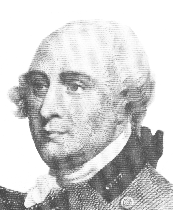 |
|
Lord Dorchester |
To compensate its faithful Iroquois allies for the land they lost when Britain signed the peace treaty with the Americans, the British provided the Six Nations' people with land along the Bay of Quinte and a large grant of land west of Lake Ontario along the Grand River[shaded below], which was purchased by the British government from the Mississaugas for the Six Nations people. Their needs were given every consideration and when other parts of the province had little in the way of schools and churches, the Six Nations along the Grand River were supplied with both. Their church was adorned with crimson pulpit furniture and a service of solid silver was the personal gift of Queen Anne.
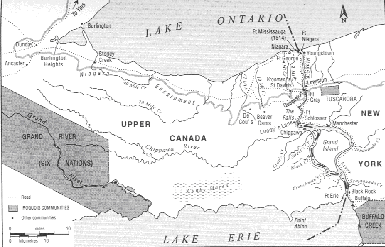 |
|
Grand River Grant (6miles on each side of the Grand River from its mouth on Lake Erid to its origin in the north) |
Britain hoped that with her help,the confederate tribes of the northwest would be able to resist the advance of American settlers into the land south of the Great Lakes. Ideally a Native buffer state here would separate the British colonies and the American settlements. Lord Dorchester warned Aboriginal sachems in 1794 that unless a line were drawn by them, the encroachment of Americans on their land as Yankee settlers forged ever-further into 'Indian territory' would ultimately mean that a line would have to be "drawn by the Warriors' children."
Governor Simcoe used all his diplomatic skills to convince these "firm friends of the British" that it was in their best interests to remain loyal to the king. Britain's alliance with the Aboriginals was maintained with supplies and other presents, including the customary practice of "distinguishing the Chiefs by a Private Donation." The provision of presents recognized the sacredness of treaty promises. Whatever was once written down and signed by sovereign and the sachem would bind the parties for as long as the "sun shines and the rivers flow. " Like the rainbow the treaties would beam unbroken and the Natives pledged their word to this by delivery a Wampum Belt of Shells.
The Indian Department became a quasi-military institution created to cater to the needs of Britain's vital allies. A critical function of its agents was to maintain the "union of the Indian Nations and exert all influence to encourage and cement the same." A strong union of the Native Nations was all important.
The Indian Department became increasingly active following the Chesapeake Affair in 1807. British pursuit of deserters on the American frigate, Chesapeake, resulted in a number of men being killed and wounded.American anger at this arbitrary assault almost catapulted the country into war.This threat of conflict quickly revived the British-Aboriginal alliance. Passions were inflamed as Native braves were regularly reminded of the loss of their land to the artful Americans. While braves were cautioned against any unilateral acts of aggression against the Americans, it was clearly understood that if Native aid was needed by the British, warriors would be ready. At the time, British plans for the braves was defensive not offensive.
The Indian Affairs department's traditions were set by Sir William Johnson and carried on by the Department's dedicated members like William Claus, deputy superintendent of the Six Nations at Fort George. During the war of 1812, Claus was named colonel of the 1st Lincoln Militia and in that capacity he met regularly in council with Natives at Fort George. Before 1830 the central function of the Indian Department in British North America was to provide presents as signs of friendship and alliance. The origin of providing presents is unclear, but they had been paid before the American War of Independence and became even more important as a result of this conflict.
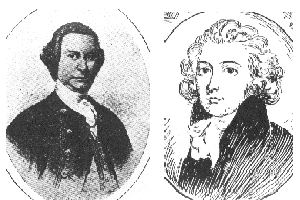 |
|
Sir Wm Johnson & Colonel Wm Claus |
The necessity of keeping Aboriginal allies in strong bonds of friendship made the annual giving of presents a vital aspect of British military policy. Agents were appointed exclusively for this purpose and funds were provided directly from Imperial parliamentary grants. The military necessity for these presents continued until after the War of 1812.By the end of 1820 it was becoming clear that the Natives' role as allies was becoming less important and a new policy was implemented whose purpose was "to civilize and Christianize" the Natives and convince them to settle down and take up farming.
The new priority was to buy up Native land and free it for occupancy by whites as it became clear that the Natives were impeding settlement in Upper Canada. The sale price of the land was to be used to sustain the tribes who were to be relocated to tracts of land known as 'reserves.' The land agreements contained clauses such as "the proceeds of the land surrendered shall be applied towards educating your children and instructing yourselves in the principles of the Christian religion with certain portions of the said tract set apart for your accommodation and that of your families on which homes will be erected as soon as possible."
The Indian department became responsible for overseeing the sale of Aboriginal lands, collecting and investing the monies therefrom and administering these funds until the Native peoples were taught to assume this responsibility themselves and so eliminate the necessity for the department. The Indian Department changed from a military to a maintenance function, as its members fought for adequate funding to assist the Aboriginals to adapt to a new way of life.
Copyright © 2013 Website Administrator